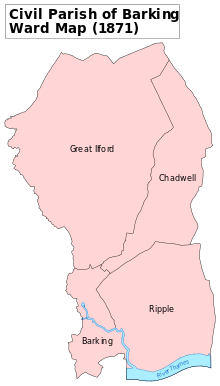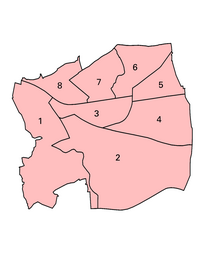| Barking Barking Town (1882–1931) | |
|---|---|
 Barking Town Hall (built 1958) | |
 Barking within Essex in 1961 | |
| Area | |
| • 1911 | 3,805 acres (15.4 km2) |
| • 1931 | 3,809 acres (15.4 km2) |
| • 1961 | 3,877 acres (15.7 km2) |
| • Coordinates | 51°32′09″N0°04′43″E / 51.5358°N 0.0785°E |
| Population | |
| • 1911 | 31,294 |
| • 1931 | 51,270 |
| • 1961 | 72,293 |
| Density | |
| • 1911 | 8.2/acre |
| • 1931 | 13.5/acre |
| • 1961 | 18.6/acre |
| History | |
| • Origin | Barking ancient parish |
| • Created | 1882 |
| • Abolished | 1965 |
| • Succeeded by | London Borough of Barking London Borough of Newham |
| Status | Local board district (1882–1894) Civil parish (1888–1965) Urban district (1894–1931) Municipal borough (1931–1965) |
| Government | Barking Town Local Board (1882–1894) Barking Town Urban District Council (1894–1931) Barking Borough Council (1931–1965) |
| • HQ | Barking Town Hall, Clockhouse Avenue |
| • Motto | Dei gratia sumus quod sumus (By the grace of God we are what we are) |
 Coat of arms of the borough council [1] | |
Barking was a local government district, and later civil parish and borough, in southwest Essex, England from 1882 to 1965. It was known as Barking Town from 1882 to 1931. The district included the town of Barking, eastern Beckton and the southwestern part of the Becontree estate. [2] The district was within the Metropolitan Police District and experienced a steady increase in population during its existence. The area was suburban to London's conurbation region and was part of the Metropolitan Police District. It now forms the western part of the London Borough of Barking and Dagenham and the eastern extremity of the London Borough of Newham in Greater London.


